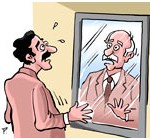I have noticed that as the Mysore-style Ashtanga method becomes more popular over the years, the individual connection between teacher and student is disintegrating. The practice, which was originally designed to be individualized, has become increasingly supplanted by a one-size-fits-all approach.
This is a natural outgrowth as more and more people both learn and are touched by the method. The unfortunate thing is that it misses the point of the Mysore-style methodology, which by its nature honors each student’s constitution, body, emotions, personal development, culture, etc. The problem is that as yoga becomes increasingly popular, the practice is morphing into something that alienates the practitioner from his or her own wisdom. In the Ashtanga world this change is being called “traditional” ; however, I want to posit the notion that there is nothing traditional about it; in fact, it is an unfortunate and new result of the popularity of yoga. And if we continue to alienate our student’s innate wisdom from the practice, Mysore-style yoga will become a practice for only the select few.
Unlike led classes, the Mysore-style allows for a relationship to arise between the student and the teacher in such a way that the practice can be made to fit the student, as opposed to the other way around. In led classes, generally speaking, it is difficult for the teacher to work much on an individual basis with the student because he or she has to ensure the flow of the class as a whole. Mysore-style, however, is the equivalent of a private master class with the support of group energy. In other words, a student has the opportunity to be inspired both by the intensity of the class and the direction and support of the teacher. When a student finds his or her yoga home, indeed, it is like coming home. Both the relationship with the teacher and the class as a whole cradles and supports them in achieving yoga, however the student chooses to define that word.
Breakthroughs
Over the years, I have noticed within the Ashtanga world that yoga has increasingly become defined as the mastery of asanas as opposed to the achievement of yoga. The goal of yoga has become the need to bind the hands in marichyasana d in order to progress through primary series or stand up from a back bend in order to move to intermediate series. Frankly speaking, milestones like this are not helpful. Many, many individuals will never be able to bind in marichyasana d because constitutionally they just cannot. What often happens is that people will compromise their knees in order to get into the posture. So marichyasana d becomes the source of a medial meniscus tear. Likewise in an effort to stand up from back bends, students often injure their backs. The result of trying to master asanas is often a long-standing injury from repetitive strain. As Pattabhi Jois used to say, “Health will result from good yoga, ill-health will result from bad yoga.” Clearly, this is bad yoga.
The myth generated amongst practitioners of this method that if we push through pain, we are likely to have a breakthrough known amongst so-called ‘aficionados’of this method as an “opening.” When someone says “opening” they mean the ability to complete a posture that they could not previously complete because something opened up or let go. Most so-called ‘openings’ that I have seen over the years are repetitive strain injuries caused by a blatant disregard for the body’s signals that what they’re doing is painful. I have to admit that I stand in contrast to most so-called ‘traditional’ practitioners when I admit that, generally speaking, I don’t believe in openings. I have wanted to over the years. There have been many, many times when I have told myself and my students that the pain they’re experiencing is just an opening, but I have seen enough ‘openings’ to know that the idea is wishful thinking.
The first time I visited Mysore, in 1993, I saw a friend from New Zealand get injured in janu sirsasana c. His visit to Mysore was shortened from a three-month stay to one-month because his lateral collateral ligament had been totally ruptured. What struck me about that particular incident was that my friend had been complaining of pain in his knee. Various prominent practitioners and member of the community had advised him to keep pushing forward, that he would eventually have a breakthrough. Essentially, he was discouraged from recognizing his own pain receptors telling him that his knee was in danger.
Ashtanga is a rigorous practice and injuries do take place sometimes that are deleterious, but to overlay the problem with a false statement, like “oh, it’s just an opening” is like putting ice cream on top of crap and saying that the whole thing is ice cream, so eat it up. That’s the problem when we disregard our own common sense in place of tradition. I am not saying that it isn’t useful to look at the experience of pain and injury as an opportunity to grow or develop in a inner way. Our injuries can be some of our best teachers. What I am saying is that pain is usually an indicator that there is something wrong. It is the body’s intelligence speaking. In all the years I have been practicing and teaching, I have rarely seen the notion of breakthroughs pan out
Tradition
We all want certainty. We somehow think that if we align ourselves with a lineage that is thousands of years old, that its wisdom will keep us warm on a cold night. After all, if we look at our modern lives in reference to more traditional cultures, we can see that in many ways we are lonelier, more isolated, and have a greater propensity toward feelings of meaninglessness . I think it's natural to want to align oneself with the old and great traditions in order to feel a part of something greater.
Unfortunately, more often than not, we see individuals clinging to traditions that are foreign or “other” who may in some sense find a connection but often are, likewise, cut-off from themselves. One of our students told me that when she discovered yoga and its teachings, that she was so enamored by the truth of the words that she heard and the practice, that she decided to park her old, lonely self at the door in order to embrace the teachings fully. Through our discussions together, she discovered that what she had done is cut herself off from sides of herself, wisdom and intelligence that had been cultivated for years before her introduction to the practice. And by parking her lonely self at the door, she cut off from those sides of herself that needed tending to. Since making that decision, she felt very satisfied when reading about, discussing, or practicing yoga, but her parked problems kept nagging her. Eventually through probing, she came to discover that the true test of the practice was to use them on those parts of herself that felt lonely and isolated as a way to discover the their actual power.
When I started yoga, I remember there being a sort of strict division between Ashtanga and Iyengar practitioners. Somehow for the Iyengar yogis, we had it all wrong. We lacked alignment and precision, and every one of us was prone to injury. And we thought they had it all wrong. Their practice was totally boring, static, and mental. As Ashtanga has become increasingly popular in the last few years, I have seen this division between practitioners within the method itself that is similar, either you’re traditional or you aren’t. This idea of being ‘traditional’ is a new creation. It simply didn’t exist until recently. Not that the method wasn’t exact. Indeed, it was, but because the room in Mysore was so small, each individual was tended to in a unique way. Many of Guruji’s old students, including myself, will tell you that he would tell one person one thing about a particular asana or about the method as a whole and then absolutely contradict himself with someone else.
This idea that somehow the method is monolithic, ancient, perfect, and precise is something we wish were true but isn’t. Pattabhi Jois said that he received the teachings exactly as he taught them from his teacher, Sri Tirumalai Krishnamacharya, who learned the method from his teacher, Rama Mohan Brahmachari, and so on. The idea is that at no time was the system tainted, but, instead, it was passed down from generation to generation for thousands of years in pristine form. The system is linked to a source text no longer in existence called the Yoga Korunta, which was supposedly written by a sage named Vamana Rishi and was imparted from Rama Mohan Brahmachari to Krishnamacharya. At some point the text was written on palm leaves, which were in the safe keeping of Pattabhi Jois, as the legend goes, but somehow insects destroyed the text. All of this description creates the myth that somehow the practice has some profound history and its transmission has been untainted from time immemorial.
But in purusing the notion of tradition a bit further, I came across The Yoga Tradition of the Mysore Palace by N.E. Sjoman. Sjoman makes the following compelling argument: the yoga system taught by Krishnamacharya comes from a merging of gymnastics with yoga. The author drew his conclusions by mining the royal library in Mysore, where Krishnamacharya taught during the time he taught Pattabhi Jois. Krishnamacharya was appointed to the Mysore Palace in the early 1930s to teach yoga to the Arasu boys, the maternal relatives of the royal family. Through the patronage of Nalvadi Krishanarja Woodeyar, he opened a yoga shala or yoga school which continued until 1950. The author makes a very compelling argument that Krishnamacharya not only developed the Ashtanga system as taught by Pattabhi Jois during his tenure in Mysore, but that he drew on elements of gymnastics and Indian wrestling.
So, not only is it a misnomer that somehow the system has been perfectly sustained for thousands of years, it is easily argued that the system was created in the 1930s to some degree or another and has sources outside of the yoga tradition. And in the bit of history we have of Ashtanga from the vantage point of long-time Western practitioners, one can see that the system has been changed to one degree or another since 1973. Postures have been added and subtracted. The length or duration of holding postures has been changed. Even sequences have been changed. Third series today is only a fraction of the old Advanced A series and its sequencing has changed somewhat. Students who completed first were moved on to second without the barrier of getting up from backbends. Pranayama was taught after completing primary series initially. Then eventually, it was taught after completing intermediate series. Now, supposedly, it is taught after completing Third series. To say that the practice has sanctity through historicity just is not true. It is a living, changing phenomena.
The New Tradition
And as the method is being passed to the next generation of practitioners, it continues to mold and change. So to say that there is a ‘traditional’ way to practice doesn’t actually mean that there is this vast history that supports it. Instead, what traditional means is what is currently being taught in Mysore at the given moment. Pattabhi Jois’ family, essentially determines the ‘traditional’ nature of things. And as the torch has been passed on to Jois’ grandson, Sharath, he currently determines what, in fact, is traditional.
The notion of standing up from backbends in order to progress to intermediate series was created by Sharath. This is just one so-called ‘tradition’ that has recently been added to the practice in order to manage the influx of students coming to Mysore. So many people show up in Mysore today that it is increasingly impossible for the teacher to give much individual instruction. In order to counter this, every Friday and Sunday, led classes are given. Led classes, generally did not exist before Pattabhi Jois moved from his yoga shala in Lakshmipuram to his shala in Gokulam. In addition, more focus is being played on backbends than ever before. Essentially the tradition is going through another metamorphosis and is being influenced by the influx of people attracted to the power of yoga.
That being said, tradition is based upon agreement. When that agreement lacks discrimination the risk of damage can be great. I write this because the practice and community have meant so much to me. I hate to see Ashtanga Yoga go in this direction. What lead me to the practice, in the first place, was the fact that individuality was honored. Each of us who maintains the practice has a stake in maintaining its authenticity and longevity. My personal stake is that as Ashtanga continues to develop that it continues to honor the individual rather continuing to evolve into a one-size-fits-all method in the name of tradition.




 The transformational shift that can occur around the sacred wound feels a whole lot like a descent. It has a downward quality to it. It often feels heavier, stickier, thicker, and more difficult before it ever starts to feel better. In 12-step programs, they often say that one has to hit 'rock-bottom' before any real change can take place. When we acknowledge the emotion around the wound in a deliberate, conscious way, we take ourselves to a 'rock-bottom' place.
We expect and seek to create a sort of descent. At the bottom of the descent is both an acknowledgement and acceptance of the wound. People often report a sigh of relief. What they recognize is that those aspects of the wound that they’ve disowned becomes included into who they are. There is a very clear sense of widening, deepening, and expanding at the moment in which the descent has completed itself.
The transformational shift that can occur around the sacred wound feels a whole lot like a descent. It has a downward quality to it. It often feels heavier, stickier, thicker, and more difficult before it ever starts to feel better. In 12-step programs, they often say that one has to hit 'rock-bottom' before any real change can take place. When we acknowledge the emotion around the wound in a deliberate, conscious way, we take ourselves to a 'rock-bottom' place.
We expect and seek to create a sort of descent. At the bottom of the descent is both an acknowledgement and acceptance of the wound. People often report a sigh of relief. What they recognize is that those aspects of the wound that they’ve disowned becomes included into who they are. There is a very clear sense of widening, deepening, and expanding at the moment in which the descent has completed itself.







